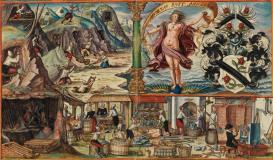During the Early Modern Period mining was among the most important economic driving forces, which also had large effects on material culture, perceptions and validations of metallic ores in central European mining regions. Proceeding from the conflated notion of gold and silver, both as symbols of value and as generators of it, this project investigates the perceptions and transformations of value connected with the different aggregate conditions of metallic ores in sixteenth and seventeenth century elite, scholarly and artisanal circles. This analytical focus upon perceptions and transformations of value combines economic considerations with an attention towards metallurgical practices and techniques such as smelting, assaying, alloying or even transmuting minerals and metals. Geographically the analysis is directed towards the duchies of Saxony, Braunschweig and the territories of Further Austria. Of major interest for this project are the interdependences of actors, objects and specific “sites” of mining, metallurgical processes or mineral display (alchemical laboratories, goldsmith workshops, mints or mineral collections and curiosity cabinets). From the methodological background of renewed interest in history of science on commerce and the global development of science as well as on transmission and movement of knowledge and objects, this investigation of the material and epistemic cultures of the mines contributes to a connected history of the mostly separated fields of economy, art and science.

